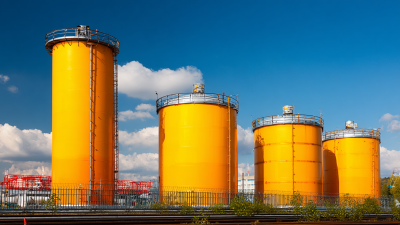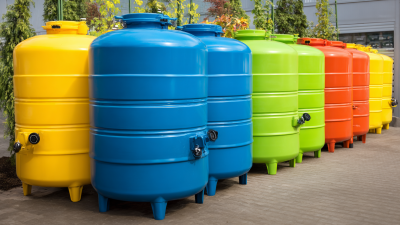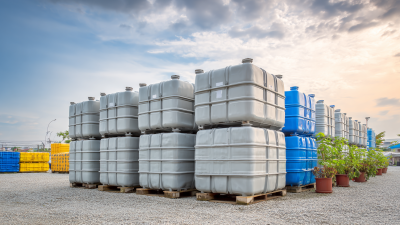In today's industrial landscape, the utilization of plastic storage tanks has become increasingly prominent due to their versatility and numerous advantages. As organizations seek efficient and cost-effective solutions for storing various liquids, plastic storage tanks have emerged as a favorable alternative to traditional storage options. These tanks are not only lightweight and durable but also resistant to corrosion, making them ideal for diverse applications ranging from water and chemical storage to waste management. Understanding the benefits and optimal use of these tanks is essential for businesses aiming to enhance efficiency and safety in their operations. This guide will explore industry insights and provide practical recommendations for maximizing the potential of plastic storage tanks, ensuring that organizations can make informed decisions tailored to their specific needs.

Plastic storage tanks have gained significant traction across various industries due to their durability, lightweight nature, and resistance to corrosion. According to recent industry reports, the water storage system market is projected to grow, with plastic materials accounting for a substantial share due to their cost-effectiveness and versatility in applications. For instance, in sectors like agriculture, chemical processing, and wastewater management, plastic tanks are increasingly favored for their ability to handle various types of liquids without the risk of rust or degradation.
When utilizing plastic storage tanks, it’s essential to consider the specific requirements of your application. For optimal use, ensure that the tank material is compatible with the stored substances, as some chemicals can react adversely with certain plastics. Regular inspection and maintenance can extend the lifespan of your storage tanks.
Tips:
The durability and longevity of plastic storage tanks are critical factors driving their adoption across various industries, particularly in water treatment, oil and gas, and chemicals. The introduction of innovative multi-layer technologies is setting new standards for strength and resistance to environmental stressors. For instance, advancements in manufacturing techniques have led to the creation of tanks with enhanced features that prevent leaks and degradation over time, ensuring safe and efficient storage solutions.
Moreover, as industries increasingly recognize the importance of sustainable practices, the demand for robust and long-lasting storage options rises. With projected growth in the storage tank market, driven by expanding industrial sectors, it's essential for stakeholders to invest in high-quality plastic tanks that offer excellent performance and longevity. These tanks not only withstand harsh conditions but also align with broader environmental goals, further emphasizing the importance of durable solutions in today’s market landscape.
When it comes to maximizing storage efficiency in various industries, optimal sizing and configuration of plastic storage tanks are critical factors. Proper sizing begins with a thorough assessment of both current and future storage needs. It's important to consider the types of materials being stored, as well as fluctuating demand. For instance, tanks should provide adequate capacity for peak usage times, while also ensuring that space is utilized effectively to minimize associated costs.
In terms of configuration, the layout of the storage tanks can significantly impact operational efficiency. Strategically placing tanks in a manner that facilitates easy access for loading and unloading can streamline workflows. Additionally, utilizing vertical storage options can save floor space while maximizing volume. It is also advisable to incorporate features such as level indicators and automated monitoring systems to maintain optimal conditions and reduce manual oversight. By integrating these considerations, businesses can enhance their storage capabilities and create a more efficient operational environment.
| Tank Size (Gallons) | Material Type | Application Type | Configurations | Recommended Uses |
|---|---|---|---|---|
| 500 | Polyethylene | Water Storage | Vertical, Double Wall | Irrigation, Rainwater Harvesting |
| 1000 | Polypropylene | Chemical Storage | Horizontal, Single Wall | Agricultural Chemicals |
| 2000 | High-Density Polyethylene | Wastewater Storage | Above Ground, Conical Bottom | Environmental Services |
| 3000 | Fiberglass | Oil & Fuel Storage | Vertical, Dual Containment | Petroleum Products |
Plastic storage tanks offer significant cost-effectiveness compared to traditional storage solutions like metal and fiberglass tanks. The lower initial purchase price of plastic tanks makes them a budget-friendly option, particularly for industries needing large volumes of storage. Additionally, plastic tanks are lighter, which reduces transportation costs and simplifies installation. This lightweight nature also allows for easier relocation, making them an attractive choice for operations that require flexibility in storage solutions.
Moreover, the durability and maintenance requirements of plastic tanks further enhance their cost-effectiveness. Unlike metal tanks, which are prone to rust and corrosion, plastic tanks are resistant to various chemicals and environmental conditions. This resistance leads to reduced maintenance costs over time, as fewer repairs and replacements are needed. Furthermore, the longevity of plastic tanks often exceeds that of their metal counterparts, providing a better return on investment in the long run. By comparing the lifecycle costs, industries can easily see the financial advantages of opting for plastic storage solutions.
When it comes to maintaining plastic storage tanks, adopting best practices can significantly extend their lifespan and enhance performance. Regular inspections are crucial; these should focus on identifying any signs of wear, damage, or chemical corrosion. Operators should establish a routine schedule to check for cracks, leaks, or discoloration, which can indicate deterioration over time. Cleaning tanks before and after use, particularly when storing different substances, helps prevent contamination and minimizes chemical reactions that could weaken the plastic.
Another vital aspect of maintenance is ensuring that the tanks are stored and operated within recommended temperature ranges. Extreme heat or cold can affect the integrity of the plastic, leading to warping or brittleness. Additionally, using proper supports can prevent stress on tank walls. For instance, placing tanks on flat surfaces and securing them against potential impacts will aid in maintaining structural integrity. By following these maintenance best practices, businesses can optimize the use of plastic storage tanks, ensuring they serve their intended purpose effectively and safely for years to come.
This bar chart illustrates the percentage of various benefits associated with the use of plastic storage tanks in different industries. The data shows the advantages plastic tanks offer, such as corrosion resistance, lightweight, cost-effectiveness, and ease of installation.






